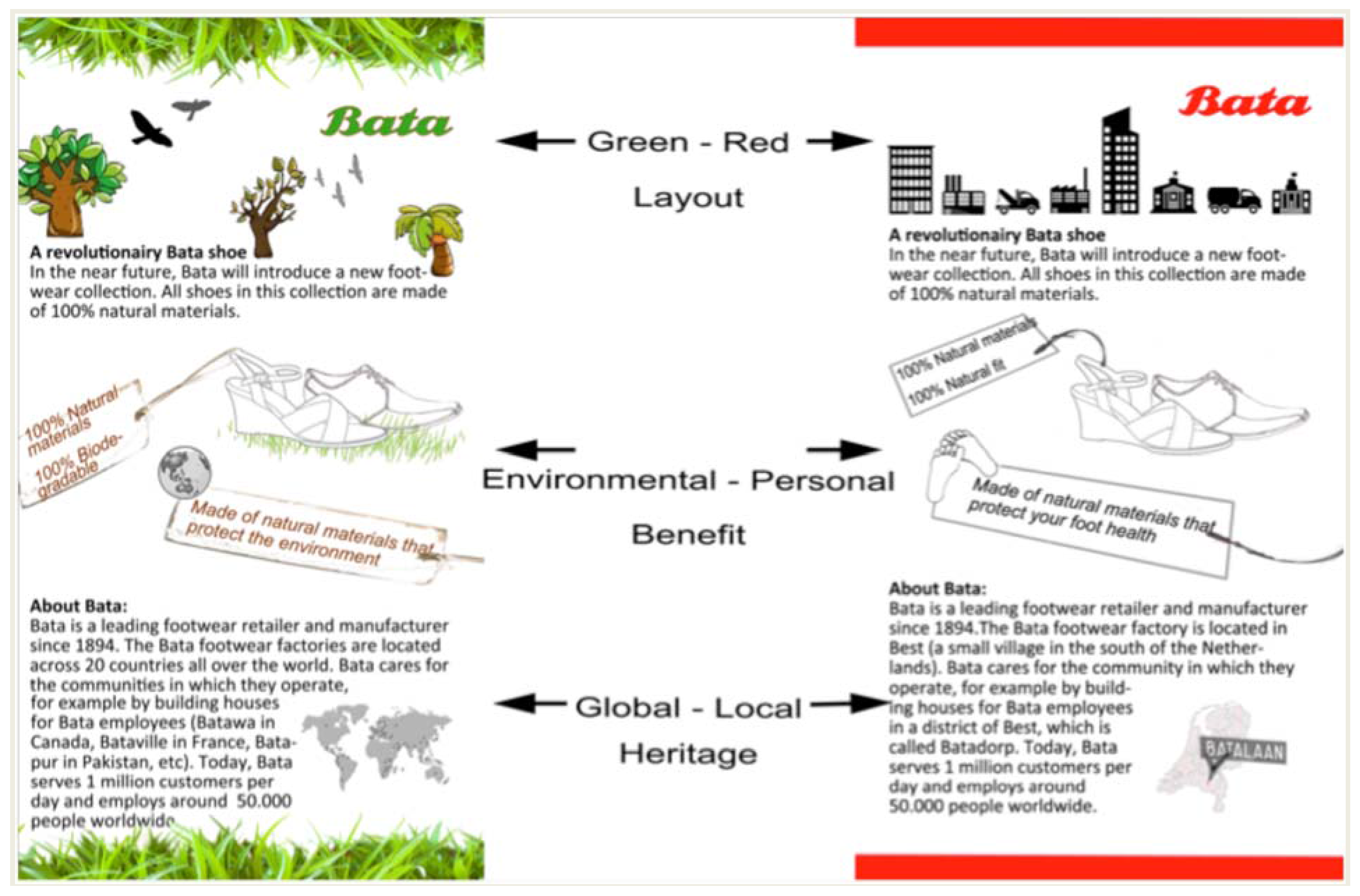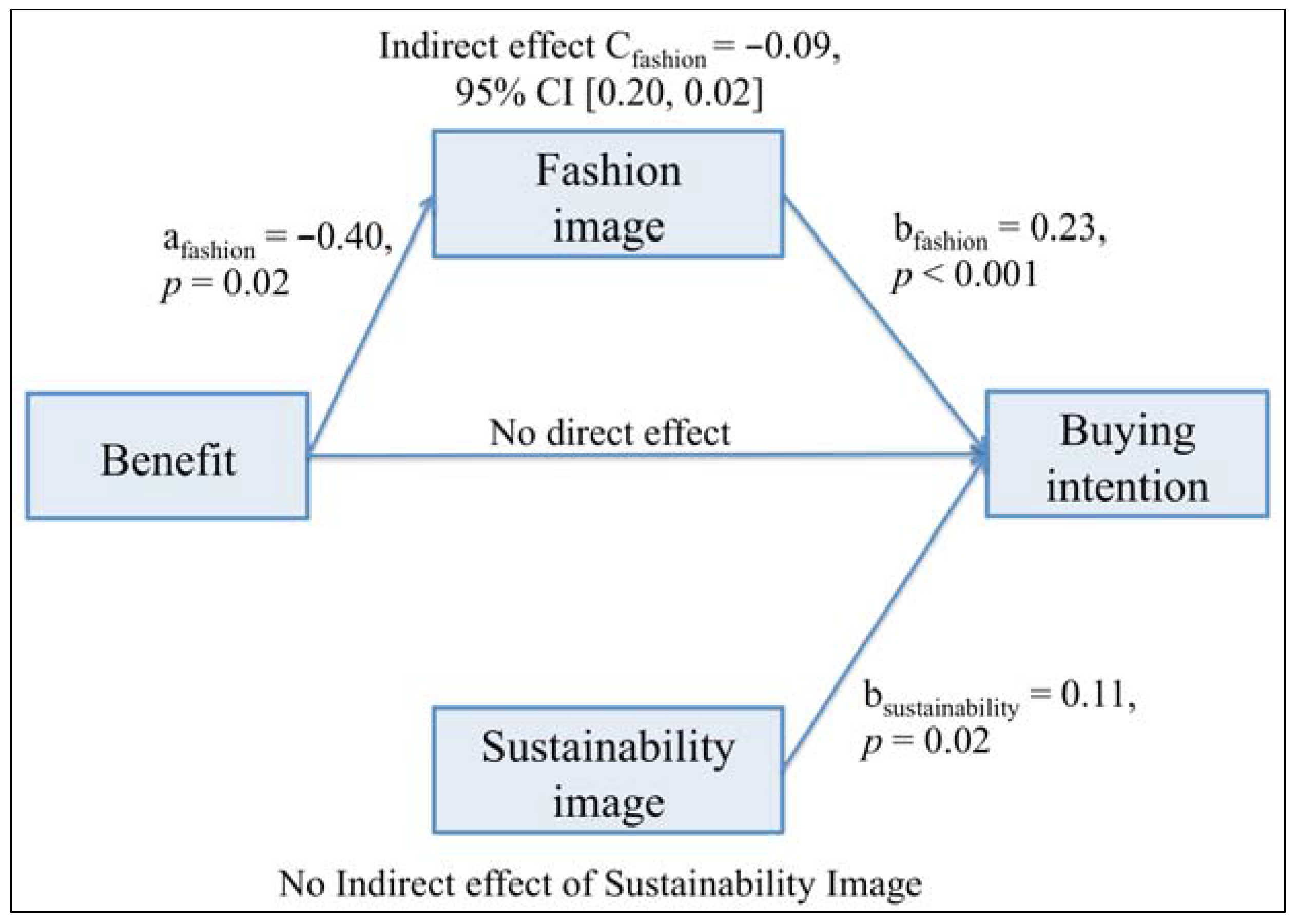Communicating Sustainable Shoes to Mainstream Consumers: The Impact of Advertisement Design on Buying Intention
Abstract
:1. Introduction
2. Marketing and Advertising of Sustainable Products
2.1. Green Marketing Evolves in Marketing Greener Products
2.2. Advertising Sustainable Products
2.2.1. Color of the Advertisement Layout
H1: When advertisements are based on a green layout as opposed to a red layout, participants will report higher buying intentions.
2.2.2. Environmental vs. Personal Benefit
H2a: When advertisements emphasize a personal benefit (e.g., “protects your foot health”) as opposed to an environmental benefit (e.g., “protects the environment”), participants will report higher buying intentions.
H2b: Participants report the highest buying intentions when presented with the personal benefit combined with the green layout.
H2c: When advertisements emphasize an environmental benefit (e.g., “protects the environment”) as opposed to a personal benefit (e.g., “protects your foot health”), participants will rate the shoes lower in its perceived fashion image.
H2d: When advertisements emphasize an environmental benefit (e.g., “protects the environment”) as opposed to a personal benefit (e.g., “protects your foot health”), participants will rate the shoes higher in its perceived sustainability image.
2.2.3. Global vs. Local Heritage
H3: When advertisements emphasize local heritage as opposed to global heritage, participants will report higher buying intentions.
3. Methodology
3.1. Participants
3.2. Independent Variables and Stimuli

3.3. Dependent Variables
3.4. Procedure and Design
4. Results
4.1. Manipulation Checks
4.1.1. Sustainability of the Layout
4.1.2. Communicated Benefit
4.1.3. Communicated Heritage
4.2. The Impact of Layout, Benefit Type and Heritage on Buying Intention

4.3. The Impact of Layout, Benefit Type and Heritage on Fashion Image and Sustainability Image
4.4. Mediation by Fashion Image and Sustainability Image

5. Discussion
5.1. Discussion of the Results
5.1.1. Impact of the Color of the Layout on Buying Intention
5.1.2. Impact of the Communicated Benefit on Buying Intention
5.1.3. Interaction between Color of Layout and Communicated Benefit
5.1.4. Impact of the Communicated Heritage on Buying Intention
5.1.5. Impact of Communicated Benefit on Fashion Image and Sustainability Image
5.1.6. Mediation of Fashion Image and Sustainability Image on Buying Intention
5.2. Limitations and Further Research
5.3. Implications for Marketers
6. Conclusions
Author Contributions
Conflicts of Interest
References
- Ottman, J.A. The New Rules of Green Marketing, Strategies, Tools and Inspiration for Sustainable Branding; Berrett-Koehler Publishers Inc.: San Francisco, CA, USA, 2011. [Google Scholar]
- Peattie, K.J.; Crane, A. Green marketing: Legend, myth, farce or prophesy? Qual. Mark. Res. 2005, 8, 357–370. [Google Scholar]
- Hartmann, P.; Ibáñez, V.A.; Sainz, F.J.F. Green branding effects on attitude: Functional versus emotional positioning strategies. Mark. Intell. Plan. 2005, 23, 9–29. [Google Scholar] [CrossRef]
- Leonidou, C.N.; Leonidou, L.C. Research into environmental marketing/management: A bibliographic analysis. Eur. J. Mark. 2011, 45, 68–103. [Google Scholar] [CrossRef]
- United Nations Environmental Programme. Talk the Walk; Advancing Sustainable Lifestyles through Marketing and Communications. Available online: http://www.unglobalcompact.org/docs/news_events/8.1/ttw_fin.pdf (accessed on 30 June 2014).
- Natural Marketing Institute. Rila Stakeholder Hour—Consumer Focus. Available online: http://www.nmisolutions.com/index.php/syndicated-data/2012-global-trends-database (accessed on 14 October 2013).
- Kalafatis, S.P.; Pollard, M.; East, R.C.; Tsogas, M.H. Green marketing and ajzen’s theory of planned behaviour: A cross-market examination. J. Consum. Mark. 1999, 16, 441–460. [Google Scholar] [CrossRef]
- Pickett-Baker, J.; Ozaki, R. Pro-environmental products: Marketing influence on consumer purchase decision. J. Consum. Mark. 2008, 25, 281–293. [Google Scholar] [CrossRef]
- Rex, E.; Baumann, H. Beyond ecolabels: What green marketing can learn from conventional marketing. J. Clean. Prod. 2007, 15, 567–576. [Google Scholar] [CrossRef]
- Mendleson, N.; Polonsky, M.J. Using strategic alliances to develop credible green marketing. J. Consum. Mark. 1995, 12, 4–18. [Google Scholar] [CrossRef]
- Ottman, J.A. Green Marketing: Challenges & Opportunities for the New Marketing Age; NTC Business Books: Lincolnwood, IL, USA, 1993. [Google Scholar]
- Peattie, K. Golden goose or wild goose? The hunt for the green consumer. Bus. Strategy Environ. 2001, 10, 187–199. [Google Scholar] [CrossRef]
- McDonald, S.; Oates, C.J.; Alevizou, P.J.; Young, C.W.; Hwang, K. Individual strategies for sustainable consumption. J. Mark. Manag. 2012, 28, 445–468. [Google Scholar] [CrossRef]
- Schuhwerk, M.E.; Lefkoff-Hagius, R. Green or non-green? Does type of appeal matter when advertising a green product? J. Advert. 1995, 24, 45–54. [Google Scholar]
- Vogtländer, J.G.; Bijma, A.; Brezet, H.C. Communicating the eco-efficiency of products and services by means of the eco-costs/value model. J. Clean. Prod. 2002, 10, 57–67. [Google Scholar] [CrossRef]
- Niinimäki, K. Eco-clothing, consumer identity and ideology. Sustain. Dev. 2010, 18, 150–162. [Google Scholar] [CrossRef]
- McDonald, S.; Oates, C.J. Sustainability: Consumer perceptions and marketing strategies. Bus. Strategy Environ. 2006, 15, 157–170. [Google Scholar] [CrossRef]
- Ottman, J.A.; Stafford, E.R.; Hartman, C.L. Avoiding green marketing myopia: Ways to improve consumer appeal for environmentally preferable products. Environment 2006, 48, 22–36. [Google Scholar] [CrossRef]
- Wever, R.; Goemans, M.; Bork, S. Dissemination of the Linked-Benefit Strategy in Sustainable Marketing, Going Green, Ecodesign 2009, Proceedings of the 6th International Symposium on Environmentally Conscious Design and Inverse Manufacturing, Saporo, Japan, 7–9 December 2009; Fujimoto, J., Itoh, T., Masui, K., Umeda, Y., Eds.; The Japan Society of Mechanical Engineers: Saporo, Japan, 2009.
- Vogtländer, J.G.; Mestre, A.; van der Helm, R.; Scheepens, A.; Wever, R. Eco-Efficient Value Creation, Sustainable Design and Business Strategies; VSSD: Delft, The Netherlands, 2013. [Google Scholar]
- Van Doorn, J.; Verhoef, P.C. Willingness to pay for organic products: Differences between virtue and vice foods. Int. J. Res. Mark. 2011, 28, 167–180. [Google Scholar] [CrossRef]
- Grail Research. The Green Revolution. Available online: http://www.grailresearch.com/pdf/ContenPodsPdf/Grail-Research-Green-Evolution-Study.pdf (accessed on 19 August 2014).
- Hartmann, P.; Apaolaza-Ibáñez, V. Desert or rain. Eur. J. Mark. 2013, 47, 917–933. [Google Scholar] [CrossRef]
- Hartmann, P.; Ibáñez, V.A. Green value added. Mark. Intell. Plan. 2006, 24, 673–680. [Google Scholar] [CrossRef]
- Luchs, M.G.; Naylor, R.W.; Irwin, J.R.; Raghunathan, R. The sustainability liability: Potential negative effects of ethicality on product preference. J. Mark. 2010, 74, 18–31. [Google Scholar] [CrossRef]
- Meyer, A. What’s in it for the customers? Succesfully marketing green clothes. Bus. Strategy Environ. 2001, 10, 317–330. [Google Scholar] [CrossRef]
- Urde, M.; Greyser, S.A.; Balmer, J.M.T. Corporate brands with a heritage. J. Brand Manag. 2007, 15, 4–19. [Google Scholar] [CrossRef]
- Wiedmann, K.-P.; Hennigs, N.; Schmidt, S.; Wuestefeld, T. The importance of brand heritage as a key performance driver in marketing management. J. Brand Manag. 2011, 19, 182–194. [Google Scholar] [CrossRef]
- Alexander, N. Brand authentication: Creating and maintaining brand auras. Eur. J. Mark. 2009, 43, 551–562. [Google Scholar] [CrossRef]
- Hustvedt, G.; Dickson, M.A. Consumer likelihood of purchasing organic cotton apparel. J. Fash. Mark. Manag. 2009, 13, 49–65. [Google Scholar] [CrossRef]
- Wilson, T.D. The message is the method: Celebrating and exporting the experimental approach. Psychol. Inq. 2005, 16, 185–193. [Google Scholar] [CrossRef]
- Creswell, J.W. Research Design; Qualitative, Quantitative, and Mixed Methods Approaches, 3rd ed.; Sages Publications: Thousand Oaks, CA, USA, 2009. [Google Scholar]
- Bellman, S.; Schweda, A.; Varan, D. Minimum effective frequency for interactive television ads. J. Direct Data Digit. Mark. Pract. 2010, 11, 281–301. [Google Scholar] [CrossRef]
- Gibson, L.D. What can one tv exposure do. J. Advert. Res. 1996, 36, 9–18. [Google Scholar]
- Garvin, D.A. Competing on the eight dimensions of quality. IEEE Eng. Manag. Rev. 1996, 24, 15–23. [Google Scholar]
- Hayes, A.F. Introduction to Mediation, Moderation, and Conditional Process Analysis: A Regression-Based Approach; The Guilford Press: New York, NY, USA, 2013. [Google Scholar]
- Roberts, J.A. Green consumers in the 1990s: Profile and implications for advertising. J. Bus. Res. 1996, 36, 217–231. [Google Scholar] [CrossRef]
- Albers-Miller, N.D.; Royne Stafford, M. An international analysis of emotional and rational appeals in services vs goods advertising. J. Consum. Mark. 1999, 16, 42–57. [Google Scholar] [CrossRef]
© 2015 by the authors; licensee MDPI, Basel, Switzerland. This article is an open access article distributed under the terms and conditions of the Creative Commons Attribution license (http://creativecommons.org/licenses/by/4.0/).
Share and Cite
Visser, M.; Gattol, V.; Helm, R.V.d. Communicating Sustainable Shoes to Mainstream Consumers: The Impact of Advertisement Design on Buying Intention. Sustainability 2015, 7, 8420-8436. https://doi.org/10.3390/su7078420
Visser M, Gattol V, Helm RVd. Communicating Sustainable Shoes to Mainstream Consumers: The Impact of Advertisement Design on Buying Intention. Sustainability. 2015; 7(7):8420-8436. https://doi.org/10.3390/su7078420
Chicago/Turabian StyleVisser, Mirjam, Valentin Gattol, and Rosan Van der Helm. 2015. "Communicating Sustainable Shoes to Mainstream Consumers: The Impact of Advertisement Design on Buying Intention" Sustainability 7, no. 7: 8420-8436. https://doi.org/10.3390/su7078420
APA StyleVisser, M., Gattol, V., & Helm, R. V. d. (2015). Communicating Sustainable Shoes to Mainstream Consumers: The Impact of Advertisement Design on Buying Intention. Sustainability, 7(7), 8420-8436. https://doi.org/10.3390/su7078420





